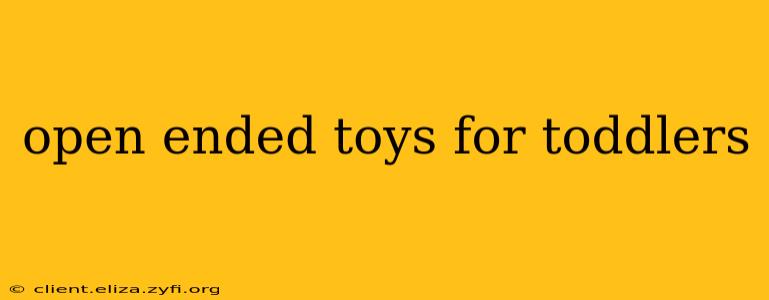Open-ended toys are a parent's best friend! Unlike toys with a single, prescribed function, open-ended toys offer a world of possibilities, encouraging creativity, problem-solving, and imaginative play. These versatile tools foster a child's development in countless ways, far surpassing the limitations of toys with fixed purposes. This guide dives deep into the benefits of open-ended toys and provides examples perfect for toddlers.
What are Open-Ended Toys?
Open-ended toys are defined by their lack of prescribed use. They don't come with instructions dictating how they must be played with. Instead, they invite children to explore, experiment, and invent their own games and narratives. This freedom allows toddlers to express themselves creatively, develop crucial cognitive skills, and build their own worlds.
Benefits of Open-Ended Toys for Toddlers
The advantages of open-ended play are numerous and profound:
- Boosting Creativity and Imagination: Without set rules, toddlers can use these toys to build, create, and imagine stories, fostering their creative thinking and storytelling skills.
- Developing Problem-Solving Skills: Figuring out how to use a toy in different ways challenges toddlers to think critically and find solutions.
- Improving Fine Motor Skills: Many open-ended toys, like blocks and stacking cups, enhance hand-eye coordination and dexterity.
- Enhancing Cognitive Development: Open-ended play stimulates cognitive processes like planning, sequencing, and spatial reasoning.
- Promoting Social and Emotional Development: When toddlers play together with open-ended toys, they learn to negotiate, cooperate, and share, improving social and emotional intelligence.
Types of Open-Ended Toys for Toddlers
Here are some excellent examples of open-ended toys perfect for toddlers:
Building Blocks:
Wooden blocks, Duplo blocks, or even large cardboard boxes offer endless possibilities for construction and creative play. Toddlers can build towers, houses, roads, or anything their imagination conjures.
Fabric Scraps and Ribbons:
Soft and safe, these materials allow toddlers to explore textures, colors, and shapes. They can be tied, draped, or used as part of imaginative play scenarios.
Play Dough and Clay:
Molding, rolling, and shaping playdough or clay encourages fine motor skill development and creative expression. Add cookie cutters or simple tools for even more possibilities.
Natural Materials:
Things like pinecones, leaves, rocks, and sticks found during nature walks can be used for building, sorting, or as props in imaginative play. Supervise carefully to ensure safety.
Stacking Cups or Rings:
These classic toys help toddlers understand size, sequence, and color while developing their fine motor skills.
Scarves or Blankets:
These can be used for imaginative play, fort building, or even as costumes, encouraging creative and dramatic play.
Simple Dolls or Stuffed Animals:
These offer companionship and can be used to act out stories and social situations.
How to Choose the Right Open-Ended Toys
Consider your toddler's developmental stage and interests when selecting toys. Prioritize safety and durability, opting for toys made from non-toxic materials. Remember that the best open-ended toys are simple and versatile, offering many opportunities for exploration and play.
Are Open-Ended Toys Better Than Traditional Toys?
Open-ended toys aren't necessarily better than other toys, but they offer a different and often more valuable type of play experience. A balanced approach incorporating both open-ended and structured toys is ideal for well-rounded development.
How Can I Encourage Open-Ended Play?
The key is to provide the toys and then step back and observe. Avoid directing the play too much. Instead, ask open-ended questions like, "What are you building?" or "What's happening in your story?" Your involvement should be supportive and encouraging, not prescriptive.
By offering your toddler a selection of high-quality open-ended toys and encouraging imaginative play, you’ll be providing them with a valuable foundation for future learning and creativity. Remember, the possibilities are as limitless as your child's imagination.
